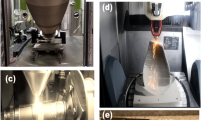Abstract
Improvements in additive manufacturing technologies will enable multiple-material and advanced material capabilities, creating opportunities to improve and expand the nuclear fuel fabrication process. Additive manufacturing can allow fuel to have complex geometries and contain composites of materials that would otherwise be difficult or impossible to make with traditional manufacturing methods. This opportunity also has implications for nuclear proliferation, as nuclear parts may be printed and more easily acquired. We present a survey of additive manufacturing technologies and relevant signatures that could be used to identify processes, materials, or part properties.








Similar content being viewed by others
References
1. Fish S, Booth J, Kubiak S, Wroe W, Bryant A, Moser D, Beaman J (2014) Design and Subsystem Development of a High Temperature Selective Laser Sintering Machine for Enhanced Process Monitoring and Control. Additive Manufacturing DOI 10.1016/j.addma.2014.12.005
2. Ford S, Despeisse M (2016) Additive manufacturing and sustainability: an exploratory study of the advantages and challenges. J of Clean Prod. 137:1573–1587
3. Gibson I, Rosen D, Stucker B (2009) Additive Manufacturing Technologies: Rapid Prototy** to Direct Digital Manufacturing. Springer
4. Harvey, M et al. (1969) Fabrication of Oxide Nuclear Fuel Pellets. Dow Chemical Company, Rocky Flats Plant
5. Lee H, Lim C, Low M, Tham N, Murukeshan V, Kim Y (2017) Lasers in additive manufacturing: A review. Int J of Precis Eng and Manuf-Green Technol. 4: 307–322
6. Ngo T, Kashani A, Imbalzano G, Nguyen K, Hui D (2018) Additive manufacturing (3D printing): A review of materials, methods, applications and challenges. Composite Part B: Engineering. 143:172–196
7. Seepersad, C (2014) Challenges and Opportunities in Design for Additive Manufacturing. 3D Printing and Additive Manufacturing, vol. 1, no. 1 https://doi.org/10.1089/3dp.2013.0006.
8. Verma R, Kaushal G (2018) State of the Art of Powder Bed Fusion Additive Manufacturing: A Review. 3D Printing and Additive Manufacturing Technologies. Springer, Singapore
9. Yap C, Chua C, Dong Z, Liu Z, Zhang D, Loh L, Sing S (2015) Review of selective laser melting: Materials and applications. Applied Physics Reviews 2. https://doi-org.ezproxy.lib.utexas.edu/10.1063/1.4935926
10. Additive Manufacturing and Nuclear Nonproliferation. https://stanleycenter.org/publications/additive-manufacturing-and-nuclear-nonproliferation-shared-perspectives-on-security-implications-and-governance-options/. Accessed 12 Apr 2022
Acknowledgements
The authors would like to thank Patrick Snarr and Derek Haas for their contributions in advising throughout the research process. We would like to additionally thank The University of Texas at Austin for the use of their research facilities and machines. We would also like to thank the Consortium for Enabling Technologies and Innovation for funding of this project under award DE-NA0003921.
Author information
Authors and Affiliations
Corresponding author
Additional information
Publisher’s Note
Springer Nature remains neutral with regard to jurisdictional claims in published maps and institutional affiliations.
Rights and permissions
Springer Nature or its licensor holds exclusive rights to this article under a publishing agreement with the author(s) or other rightsholder(s); author self-archiving of the accepted manuscript version of this article is solely governed by the terms of such publishing agreement and applicable law.
About this article
Cite this article
Gladden, B.J., Snarr, S.E. & Haas, D.A. Survey of Additive Manufacturing Signatures for the Prevention of Nuclear Proliferation. J Radioanal Nucl Chem 331, 4953–4961 (2022). https://doi.org/10.1007/s10967-022-08449-0
Received:
Accepted:
Published:
Issue Date:
DOI: https://doi.org/10.1007/s10967-022-08449-0



